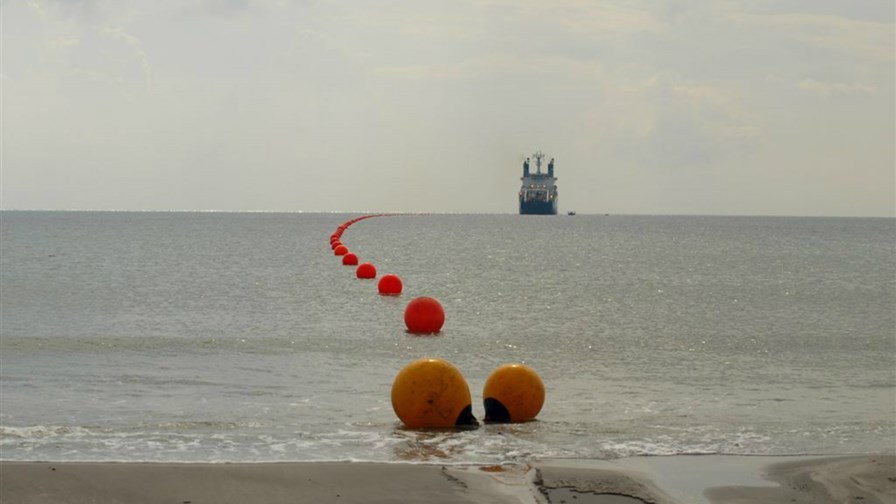
via Flickr © Global Marine Photos (CC BY-ND 2.0)
- Chunghwa forms subsea consortium as submarine ‘surge’ continues
- 2Africa submarine project bigs up
- T-Mobile US has its customer data hacked
Taiwan’s Chunghwa Telecom says it’s agreed a joint build agreement for a high performance submarine cable connecting Taiwan, Japan, Singapore, Indonesia, Philippines, and Guam. The APRICOT consortium behind the project says the 12,000-km cable is expected to be completed in 2024 and will provide more than 190Tbps capacity.
And still on submarine cable… Facebook along with China Mobile, Orange, stc, Telecom Egypt, Vodafone and WIOCC, and MTN Group are going to build a ‘wider-than-earlier planned’ sub-sea cable to service international data link demand in Africa. The companies say they’re adding the Seychelles and Comoros, as well as Angola and a new connection to Nigeria in addition to the already-announced link to the Canary Islands - bringing the total connection-landings to 35 in 26 countries. The 2Africa project will be the largest subsea cable project in the world, will deliver faster, more reliable internet service to each country where it lands. As with other 2Africa cable landings, capacity will be available to service providers at carrier-neutral data centres or open-access cable landing stations on a fair and equitable basis, encouraging and supporting the development of a healthy internet ecosystem.
Yet more submarine talk... The submarine cable announcements point to an ongoing resurgence of cable laying in response to the growing demand from content provider companies. Telegeography points out that the hyperscale content providers - Amazon, Google, Facebook, and Microsoft - (along with other content providers) share of the total submarine capacity has shot up. It accounted for less than 10 per cent prior to 2012 and has ballooned to 66 per cent in 2020 (and presumably more now).
Oops: T-Mobile confirmed yesterday that it’s investigating claims that a huge chunk of its customers’ data had been put up for sale on an online forum. According to Motherboard, which claimed to be in contact with the seller, hackers had scraped the contact details - including Social Security numbers, names, addresses, and driver license information - of more than 100 million customers from T-Mobile servers. Read more on The Verge...
Nokia and Vocus, Australia’s leading fibre and network solutions provider, have announced that Vocus is to deploy Nokia’s 1830 Photonic Service Switch between Adelaide to Darwin and Brisbane and Darwin to replace the existing optical transport network and to provide 100G and 10G services to Vocus Enterprise, Government and Wholesale customers. The deployment of 2 x 200G based wavelength unregenerated optical transport networks covers 70 sites, over a distance of 3,000 and 4,100 km respectively, and will help Vocus to optimize CapEx and reduce OpEx. Click here for more on Nokia’s 1830 Photonic Service Switch
What IDC describes as India’s ‘PC market dream run’ continues with the Indian market notching up 50% year-over-year PC shipment growth in the second quarter. The Indian PC market comprises laptops, desktops, notebooks and workstations, with 3.2 million shipped in the quarter and all categories featuring double-digit growth. IDC says the second wave of COVID-19 further delayed the opening of schools and colleges, strengthening the demand for PCs for home learning. More information can be gleaned from this link…
Services you may not have considered: Lone worker safety/security solutions. The number of people working alone in hazardous and exposed environments keeps increasing, says Berg Insights, which has been studying the US and European lone worker safety market and has produced the first edition of its downloadable Lone Worker Safety Solutions. The market itself is built around hardware devices, software solutions and alarm monitoring and response services, all glued together by communications services of course. Surprisingly, European companies are spending more than North American companies on lone worker safety, probably because of more rigorous safety regulations. Both markets combined have serviced about 1 million lone workers this year, but Europe has a user base of around 740,000 which should grow by a CAGR of nearly 10 per cent to reach 1.2 million by 2025. The North American market will grow faster (from 320,000 users at the end of 2020 to 605,000 users at the end of 2025) but will still be only half the lone user size of Europe’s.
Email Newsletters
Sign up to receive TelecomTV's top news and videos, plus exclusive subscriber-only content direct to your inbox.




